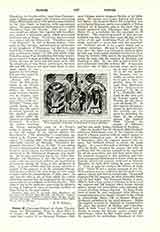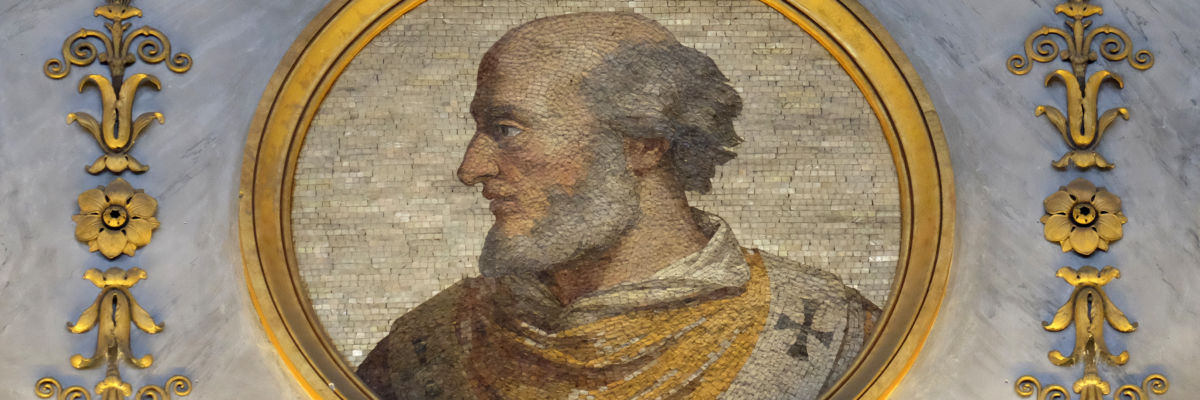

VICTOR II (GEBHARD, COUNT OF CALW, TOLLENSTEIN, AND HIRSCHBERG), POPE, b. about 1018; d. at Arezzo, July 28, 1057. The papal catalogues make him a native of the Bavarian Nordgau, while most German sources designate Swabia as his birth-place. His parents were Count Hartwig and Countess Baliza; the Emperor Henry III recognized him as a collateral kinsman, and he was a nephew of Bishop Gebhard III of Ratisbon, who at the court Diet of Goslar presented him (Christmas Day, 1042) to Henry III as a candidate for the episcopal see of Eichstatt. The emperor hesitated at first because Gebhard was only twenty-four years old, but, on the advice of the aged Archbishop Bardo of Mainz, he finally consented to invest him with this important see. Gebhard proved to be a good bishop and a prudent statesman. He was in the emperor’s retinue when the latter was crowned at Rome in 1046; he took part in the synod presided over by Leo IX at Mainz in October, 1049, and in the consultations between the pope and the emperor at Ratisbon and Bamberg in 1052. By this time he had become the most influential councillor of Henry III. It was upon his advice that in 1053 a German army, which was on its way to join Leo IX in his war against the Normans, was recalled, an advice which he is said to have regretted when he was pope (Leo Marsicanus in his “Chronicon Casinense”, II, 89, in P.L., CLXXIII, 692). Early in the same year he became regent of Bavaria for the three-year old Henry IV. In this capacity he had occasion to prove his loyalty towards the emperor by defending the rights of the empire against the deposed Duke Conrad, the counts of Scheyern, and his own uncle, Bishop Gebhard of Ratisbon.
After the death of Leo IX (April 19, 1054) Cardinal-subdeacon Hildebrand came to the emperor at the head of a Roman legation with the urgent request to designate Gebhard as pope. At the Diet of Mainz, in September, 1054, the emperor granted this request, but Gebhard refused to accept the papal dignity. At a court Diet held at Ratisbon in March, 1055, he finally accepted the papacy, but only on condition that the emperor restored to the Apostolic See all the possessions that had been taken from it. The emperor consented to this condition and Gebhard accompanied Hildebrand to Rome, where he was formally elected and solemnly enthroned on Maundy Thursday, April 13, 1055, taking the name of Victor II. Even as pope he retained the Diocese of Eichstatt. Victor II was a worthy successor of Leo IX. With untiring zeal he combated, like his predecessor, against simony and clerical concubinage. Being well supported by the emperor, he often succeeded where Leo IX had failed. On Pentecost Sunday, June 4, 1055, he held a large synod at Florence, in presence of the emperor and 120 bishops, where former decrees against simony and incontinence were confirmed and several offending bishops deposed. To King Ferdinand of Spain he sent messengers with threats of excommunication if he should continue in his refusal to acknowledge Henry III as Roman Emperor. Ferdinand submitted to the papal demands. Before the emperor returned to Germany he transferred to the pope the duchies of Spoleto and Camerino. Early in 1056 Victor II sent Hildebrand back to France to resume his labors against simony and concubinage, which he had begun under Leo IX. He appointed the archbishops Raimbaud of Arles VICTOR II WITH BISHOPS GEZMANN AND GUNDEKAR OF EICHSTATT From Gundekar’s Pontifical, the Cathedral Treasury, Eichstatt and Pontius of Aix papal legates to battle against the same vices in Southern France. Late in the summer of the same year he accepted the urgent invitation of the emperor to come to Germany, arriving at Goslar on September 8. He accompanied Henry III to Botfeld in the Hartz Mountains where on October 5 he witnessed the untimely death of the emperor. Before his death, the emperor entrusted his six-year-old successor, Henry IV, and the regency of the kingdom to the pope. On October 28, after burying the emperor in the cathedral at Speyer, he secured the imperial succession of Henry IV by having him solemnly enthroned at Aachen. He still further strengthened the position of the boy-king by recommending him to the loyalty of the princes at the imperial Diet which he convened at Cologne early in December, and at the court Diet of Ratisbon on Christmas Day.
Leaving the regency of Germany in the hands of Agnes, mother of Henry IV, Victor returned to Rome in February, 1057, where he presided over a council at the Lateran on April 18. On June 14 he created Frederick, whom he had a month previously helped to the abbacy of Monte Cassino, Cardinal-priest of San Crisogono, thus gaining the friendship of the powerful Duke Godfrey of Lorraine, a brother of the new cardinal. He then went to Tuscany, where he settled (July 23) a jurisdictional dispute between the Bishops of Arezzo and Siena at a synod held in the palace of St. Donatus near Arezzo; five days later he died. His attendants wished to bring his remains to the cathedral at Eichstatt for burial. On their way thither, the remains were forcibly taken from them by some citizens of Ravenna and buried there in the Church of Santa Maria Rotonda, the burial-place of Theodoric the Great.
MICHAEL OTT


